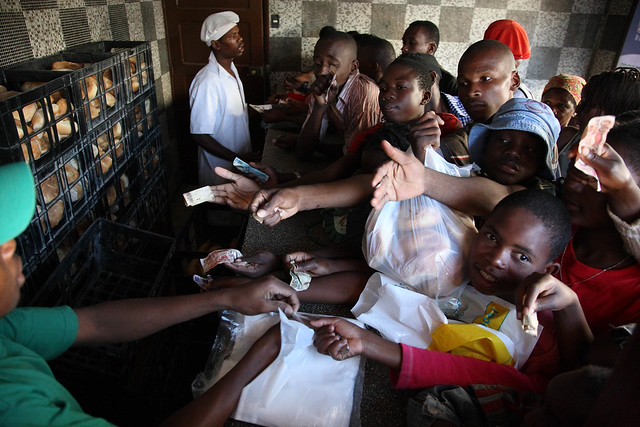 |
Rushing to buy bread as wheat runs short and food prices rise in Mozambique. Source: ILRI |
A few weeks ago, I went to my favorite neighborhood Malaysian restaurant for some spicy cuisine. Much to my surprise, I had to pay extra for the rice to complement my main dish. Pay for rice? At an Asian restaurant??? Unheard of!!
The reality is that crop prices have been rising over the past few years, affecting restaurants and grocers. But it also means that many in the developing world are losing access to crops and food.
According to Food and Agricultural Organization of the UN, in 2010, there were 925 million people in the world who did not eat enough to be healthy. That translates to one in every seven people that goes to bed hungry each night worldwide. Between June 2010 and February 2011, rising food prices caused an additional 44 million people to go into hunger, making it the highest level ever.
So why are prices of food rising? Here is a roundup of some of the causes:
- Increased food consumption: As large countries like India and China develop and their middle classes grow, their food consumption also increases. This has caused a greater demand for food globally.
- Weather conditions: Droughts, floods, and other natural disasters have plagued crop-producing regions more-so since 2008 than in previous years. Droughts, in particular, have occurred in Australia, the Balkans, Russia, and most recently, in the Horn of Africa.
- Federal reserves are low: Global grain reserves – wheat, corn, barley, millet, rice, and oats - are at their lowest level since 1960.
- Increased fuel prices: With oil prices rising, farmers can’t afford the higher transportation costs as well as the costs to commercially produce food.
- Lack of agricultural investment: In many developing countries, the investment in agriculture has dropped, with governments focusing their attention on urbanization.
- Use of crops for biofuels: Grains, such as corn and palm oil, have increasingly been used for biofuel production, raising the prices of other grains.
- Devaluation of the US dollar: Many crops are based on the US currency for pricing.





